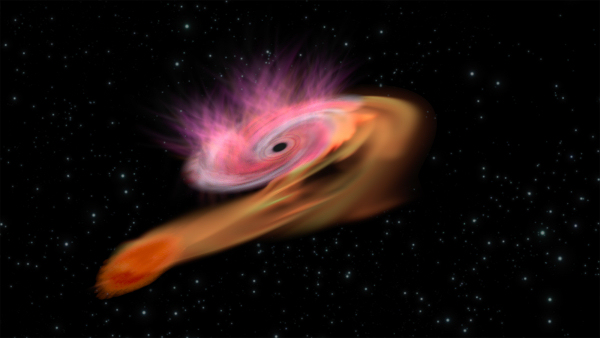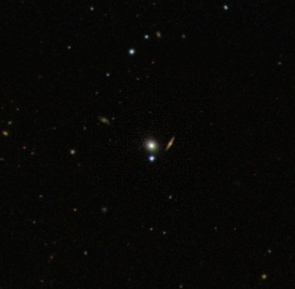Black hole caught feasting on a star
21 October 2015
Astronomers have detected the last 'cry' from a star that passed too close to the central black hole of its host galaxy and was being destroyed and 'swallowed' – a phenomenon known as a tidal disruption event. The study, based on the observations of X-rays emitted by leftover material from the star in the vicinity of the black hole, allowed the astronomers to measure, for the first time, the physical properties of a newly formed accretion disc, enabling them to investigate the initial phases of such a powerful event.
 |
| Artist's impression of a tidal disruption event. Credit: ESA/C. Carreau |
At the core of most galaxies sits a supermassive black hole, whose gravity influences the motions of stars and gas in the central regions of the galaxy. A small fraction of these black holes actively feed on the material in their surroundings through a disc, releasing powerful jets of particles and giving rise to intense emission across the electromagnetic spectrum.
The majority of these supermassive black holes, however, are not as active: an example is the one at the centre of our Milky Way, which has a mass of a few million times that of the Sun and is relatively inactive. These 'dormant' black holes have a much quieter feeding routine, only occasionally devouring a star or cloud of gas that dares to venture too close to the galaxy's centre.
On such occasions, when a star starts feeling the gravitational pull of the black hole, it experiences a stronger force on one side than on the other – something that eventually breaks the star up. In the process, stellar material starts flowing onto the black hole, where part of it is accreted and the rest ejected, producing a sudden boost in the luminosity of the galaxy, especially in X-rays.
Astronomers have been studying this phenomenon, known as tidal disruption, for over three decades, and in that time have detected dozens of black holes tearing apart and devouring stars in many galaxies, near and far.
Now, a new study led by Jon Miller of the University of Michigan, USA, offers the first close-up look into the formation of a black-hole accretion disc after a tidal disruption event. The results are published on 22 October 2015 in the journal Nature.
"All previous observations of tidal disruption events revealed an already formed disc around the black hole," says Miller, "but this is the first time that we catch such a disc in its infancy, so we can study the details of how matter starts flowing from the shattered star towards the black hole and settles in circular orbits around it."
 |
|
Optical image of PGC 043234 galaxy. Credit: Sloan Digital Sky Survey |
This source, called ASASSN-14li, was discovered on 22 November 2014 as part of an optical survey to detect supernovae, the explosive death throes of massive stars, in galaxies across the sky. Further observations revealed that this sudden spike of light was extremely close to the centre of its host galaxy, located some 300 million light-years away from us.
Soon after that, astronomers started observing this object with X-ray telescopes: ESA's XMM-Newton X-ray Observatory, and NASA's Swift X-ray Telescope (XRT) and Chandra X-ray Observatory. These data provided clear evidence of a disc of hot material flowing towards the galaxy's central black hole, which has a mass around one million solar masses and up until that time had never shown any signs of steady, active accretion.
"We immediately realised that this was a star being disrupted by the black hole, but there was more: it was the closest to be discovered in the past ten years," adds Miller.
"Given the host galaxy's relative vicinity to us, we could study the physics of this system in ever greater detail: a very rewarding outcome for a team who had been trying to decipher the puzzle of tidal disruption events for many years."
The astronomers collected light curves of this source – monitoring its luminosity over time – with Swift, and high-resolution spectra with XMM-Newton and Chandra.
"In particular, the excellent spectral resolution and large collecting area of the Reflection Grating Spectrometer on XMM-Newton enabled us to pin down the velocity of the material in the disc, its density and ionisation properties for the first time in a tidal disruption event," adds co-author Jelle Kaastra from the Netherlands Institute for Space Research – SRON.
The data also revealed signs of X-ray absorbing material beyond the disc. This could either be outflowing gas, leaving the disc via a wind, or a stream of gas flowing towards the black hole but temporarily set on a different orbit, not having settled yet in the disc with most of the leftover matter from the destroyed star.
With this new discovery, astronomers can finally study tidal disruption events with similar tools to those that have been used for many years to investigate the steadily accreting supermassive black holes at the centre of active galaxies.
"Tidal disruption events provide us a unique window onto the onset of black hole accretion, and we are looking forward to exploiting this to understand the history of supermassive black holes and their host galaxies," says Norbert Schartel, ESA XMM-Newton Project Scientist.
More information
"Flows of X-ray gas reveal the disruption of a star by a massive black hole" by Jon M. Miller, et al., is published in the 22 October 2015 issue of the journal Nature.
The study is based on observations of a transient source, ASASSN-14li, which was discovered on 22 November 2014 by the All-Sky Automated Survey for Supernovae (ASAS-SN). Follow up observations were performed with NASA's Swift X-ray Telescope (XRT) and Chandra X-ray Observatory, and with ESA's XMM-Newton.
The source is located in a small galaxy, PGC 043234, belonging to the Coma supercluster of galaxies. The galaxy is at a redshift of z=0.0206 and its light has travelled about 300 million years before reaching Earth.
The European Space Agency's X-ray Multi-Mirror Mission, XMM-Newton, was launched in December 1999. The largest scientific satellite to have been built in Europe, it is also one of the most sensitive X-ray observatories ever flown. More than 170 wafer-thin, cylindrical mirrors direct incoming radiation into three high-throughput X-ray telescopes. XMM-Newton's orbit takes it almost a third of the way to the Moon, allowing for long, uninterrupted views of celestial objects.
Contacts
Jon M. Miller
Department of Astronomy
The University of Michigan
Ann Arbour, MI, USA
Email: jonmm![]() umich.edu
umich.edu
Jelle S. Kaastra
SRON – Netherlands Institute for Space Research
Utrecht, The Netherlands
Email: J.S.Kaastra![]() sron.nl
sron.nl
Phone: +31-88-7775-870
Norbert Schartel
ESA XMM-Newton Project Scientist
Directorate of Science and Robotic Exploration
European Space Agency
Email: Norbert.Schartel![]() esa.int
esa.int
Phone: +34-91-8131-184


